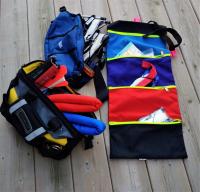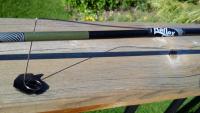-
Posts
173 -
Joined
-
Last visited
-
Days Won
17
Content Type
Profiles
Forums
Gallery
Downloads
KL Shop
Blogs
Articles
Everything posted by midibot
-
I am somewhat Old School, but to me a 'full size' stunt kite might be in the eight foot range, although there is plenty of variation a few inches either side of that, mostly less. Not sure it is a defined term, but to me a three quarter would be in the 6 to possibly approaching 7 foot range. Examples: Benson Matchbox (~76"), possibly Prism Fanatic (~72"), Flexifoil Psycho (~78"), and more modern kite: Level One Reloaded (specs say 77"). OP and others will have other examples. That said, there are six to seven footers that fly 'big' and vice-versa. .
-
I believe it was just something like 'MLD Kite Line Bag' or some such. I also have some single zipped pouches in the series. Brief search brought up this reference, but no longer available if that is true: http://www.windpowersports.com/accessories/bags/mld-line-bag.php
-
Some of my line bags. Old MLD bag (may no longer be made), Mtn Equipment (or REI etc) fanny pack, and a Stanley soft toolbag or equivalent from the hardware store. Pic attached.
-
Ahh, but your query gave rise to my interest so thanks for that. Here's a pic of my spring. Kite was new for my wife last Christmas but cannot vouch for how old it is model-wise. It may have been old stock at my vendor...? Kite is labelled as a 'Rev 1.5 Classic' fwiw -- Reflex as can be seen. Hope this works:
-
Got it. But the spring has been (re)attached - or reinforced - with heat shrink, yes? And it looks like you have some on the spring itself. Or some kind of tubing. (The newish one I am examining as we speak is bare wire, held on with some kind of tape-like stuff labelled 'Reflex'.) .
-
Neat. So, heat shrink and trimmed vinyl end cap? .
-
Picked up a set of the Matrix 75' x 90# when I recently acquired a Badass. With kite purchase, there was a nice little discount which made it a no brainer. Have used the lines maybe 1/2 dozen times on various kites and so far so good. While the orange seemed bright to my eyes on the winder, I have found that in flight there are so many other things going on that I don't really notice it unless I expressly turn my mind to it. Functionally, they are invisible, which is kinda the way I want it. Clearly visible to the eye on the ground, however (mostly grass for me). A good thing. Rather like the winder, too, which I am using along with Freilein straps. Most of my other line is older and goes way back, including some ancient BlueLine which blends in to the sky even more I think. .
-
One distinct advantage of c-clips is that they can be stuck on an assembled kite. No need in those cases to disassemble the leading edges and pull them out of the LE sleeves, which can be tricky particularly with tight connectors or some bridle attachment setups. But if you are taking it apart for replacing a broken rod, then that opens it up a bit. And, yes, they can look a little chunky. Prism used to use the glue backed heatshrink method, perhaps still does. I have, too, particularly if trying to match the other side on a Prism or other kite. Some care needs to be taken with the heat as mentioned, and it does tend to wander slightly and creep a bit as it shrinks so need to monitor that in the installation process. I have used that also for reinforcing lower spreaders at the “T”, particularly when I have repaired a split rod where I felt the crack could be mended with glue. Some kites use it there routinely and it can look good, too, if done neatly (Steve Tapp Enigma). I was just looking at the stoppers used on Lam’s Silver Fox 2.2 and it uses a clear vinyl tubing that looks kinda like the stuff used for air lines on aquariums. Neatly sliced, in the right size, it looks great for stoppers. Possibly ca’d. (A bit reminiscent of the tubing used in a heavier version as connectors in early 90s kites!) I repaired a Flexifoil Psycho a while back that used the appropriate size of vinyl end cap (“VEC”) on the original, sliced in approx 1/4 inch donuts. Dab of CA did the trick. I had the rod out anyways in that case but I have also applied the VEC solution to an assembled kite by cutting them a little longer and slicing it lengthwise for whapping it in there with that bit of glue. Another option I have seen is one or more rubber “O-rings” that you can get in the plumbing dept of the hardware store. Get it on the small side for the particular rod, and a bit of good glue. Not too obtrusive. (JoE Talon). Those are some thoughts. .
-
Nirvana. A classic. It is big(ger), slower, and very capable. Arm movements more middle-ish perhaps. Wide range of models to suit your preferences in wind. Several variants over the years, but if you can get ahold of one to fly (assuming you haven’t already) it might work for you. I, too, came back to kiting in the last couple of years and that was a kite that I had heard of and decided to try. Quite precise, yet capable of teaching me some moves without too many moments of "what the heck just happened there". Not overly sensitive or jumpy. There is a place for those… but it is sometimes nice to just Slow. It. All. Down. Anyways, that is a thought. Ymmv. .
-
Good stuff. My experience as well. The kite is so unstable without the tail that it is tricky. With time one gets better at developing the feel of when to apply pressure: when pointed in the direction you want, pull a bit and it tends to go straight(er) in that direction. Release, and it's natural tendency is to spin. Rinse, repeat To get a feel of the transition, it may help to try a length of light surveyor's tape or lengths of fat yarn tied onto the base of the spine in lieu of the factory tail - start with say half the standard tail length (my factory one is dual piece). Substitute progressively shorter bits or just tear off hunks. And wind conditions are a factor as you say, particularly at first. Lighter end of the wind range to start. Practice. Practice. Practice. It is all fun! .
-
The ITW Hata is ready to fly, with a basic line of (something like) 300 feet of 20# or so on mine. I was flying it today, and it is a steady, easy to fly single liner with the velcro'd tail attached, and quite a bit less stable sans tail, as a fighter should be. It is easy to fly from the hand with the tail as one might expect, but a second person would be useful for a launch in fighter mode at least in the early stages. I used the netting of a soccer goal as my assistant, but have also used a sideline bench, my kite bag or even a hole in the ground for the spine tip such as today (the field had been aerated recently). I used some 9# cotton line from India that worked pretty well, and is lighter than the line that comes with. The standard line should be fun enough for a while if one wanted to keep the order simple. Quite a hoot, really, and the $20 price tag is great value for money in fun. . .
-
Yes, I see that now. First in, following all four categories! ☝️ Also followed Wayne's first ad. Be interesting to see if following a category results in email notifications of new listings (checkboxed, so we'll see). .
-
Watching this with interest. If not already available, it would be useful to be able to 'follow' postings of ads (including new postings if feasible).
-
PM sent. .
-

What should I buy for a high wind lifter kite?
midibot replied to kapmelbourne's topic in KAP - Kite Aerial Photography
I have no hands on experience with kite aerial photography, but I recall looking around at the old Charles Benton site back in the day for fun. I think it has been up and down a bit of late for technical reasons, but it is a wealth of KAP oriented information if you have not checked it out yet. There is also a discussion forum, and you can search the site as well for others’ experience in a particular aspect. Thought this may be of use also to others interested in the subject. The url: http://kap.ced.berkeley.edu/kaptoc.html -
Parafoil single liner. With the dimensions you supply, the area is 56”x36”/144= 14 sq ft, so a good size and may well be a strong puller in higher wind. Premier still makes them although not sure about that size. I have the spec sheet for a Sutton Flowform 16 foil that calls for 125# line, so you are in the ballpark. (Into the Wind suggests 90# for a 7.5 sq ft version of its parafoil, and 150# for its flowform 15. Premier’s 7.5 --> 90#.) The line to use will depend of course on pull, but 120# does not seem excessive, and may or may not be enough, depending what wind you try it in. A tail may help stabilise if need be -- and/or, possibly consider “line laundry”. That colour scheme is…kinda retro Could be a lot of fun! The single line experts will chime in with more I expect. .
-
To some ears, silence is golden Other attributes may be in part kite dependent, and you are encouraged to experiment. Have not tried it on a Quantum myself, but here is a snip from the Prism manual for the Zephyr -- while it is a lighter wind kite you may find some similar results. (The effects may or may not be subtle.) Hope this image works:
-
WW = weak wind From the R-Sky description, translated from the French: "The advantage of weak winds ..."
-
The turtle (or backflip) for dualies results in nose away from the flyer. (The fade is nose towards btw.) Roy Reed’s kite move animations are a wealth of information. Here’s the link to the turtle (or backflip): https://reeddesign.co.uk/kites/tricks/turtle.html …and the fade (there are a number of ways to get there, and here is one): https://reeddesign.co.uk/kites/tricks/fade.html The American Sign Language sign for turtle IS cute. Especially moving the thumb! http://lifeprint.com/asl101/pages-signs/t/turtle.htm
-
Hey MtDandy; A cursory search led to a phone number for Rascal Kites. It may or may not be up to date, but in the circumstances I will PM you with it for the moment. If changed, it may be a start. .
-
Hey MtDandy. Sorry to hear of your problem. Have not personally heard of them prior to your inquiry, but there is a Rascal Kites listed in the directory listing merchants in the American Kitefliers Association (AKA) so it is (or was, if that has changed) an existing entity. http://aka.kite.org/local/find_mm.php?f=mrch&region=2 Do you have a phone number? A call may be in order. There may be a shipping complication for out of country orders, or other issue. It may be unrelated, but a google search brought up a couple of threads discussing problems with an entity of that name (or similar) reported in another US kite forum, GWTW. These go back a few years. If it comes to it, consider contacting your credit card company perhaps. Hope this is of some assistance and that you are able to resolve your problem. Keep us posted. .
-
Waydabe! The Quantum has the reputation of being built like a tank. You did very well to fly it in 6mph. While it is rated even lower, for me the sweet spot on the kite is maybe 8 to 10. Much more and it flies, but really hauls butt a bit (not necessarily a bad thing, if that is what you are looking for I suppose). In lower winds you have a tad more reaction time, and damage risk is reduced -- but too low in some moves the thing will just fall out of the sky like a dead bird , unceremoniously. It is a hefty kite, but a good one, and a nice early step that you can fly for a while. Mine is a green one .
-
Welcome to the forum. In reading your story I found myself smiling a bit to myself, as I recognised the signs. You are surely bit! Lots of help, advice and fun available here. Enjoy. .
-
Welcome to this wonderful aspect of kiting! The original kite uses fiberglass for the standoffs, and I would tend to stick with what the manufacturer specifies if you are trying to bring it back to spec, unless you want to experiment with the effects of modifications. Carbon and fg have different bending qualities. (I suppose if you are stuck you could switch, but do both sides if you do). There are differing grades of fg, too, so checking with HQ or a kite shop would be useful. Don't know if you still have your spec sheet, but here is a link to the english version, which states fiberglass. https://www.invento-webshop.de/hq-lenkdrachen-support/pdf_en/11677630xx_Yukon_II_CSS_en.pdf If you are replacing a standoff, the sheet says it is of 2mm dia and 210mm long. For clarification: perhaps a point of nomenclature, but when you say 'ram', do you mean the little fittings that the standoff fits into at either the sail or spreader end? Those parts can be obtained at the sources referred to elsewhere in this thread. HQ does a pretty good job on support stuff such as manuals for their kites. I see that this spec sheet even shows bridle measurements for goodness sake! Would that it were true of all kites, everywhere I have the earlier Yukon version (not the Mark II). Fun little kite -- quite capable and sturdy if a little on the small side (and a wee bit speedy). While bendy, the fiberglas they use is super durable generally, and some of the kite parts are hybrid tubes. The kite is rated for both beginner and advanced flyers on that spec sheet, so nice move on your part as you develop. HTH .
- 8 replies
-
- 2
-

-
- broken rod
- rod
- (and 4 more)
-
Thanks for posting. Gets me thinking of festivals, and it has also been forever since, for me. Looks like there are a couple of days left. May the weather and all work out for the balance of the festival! .






